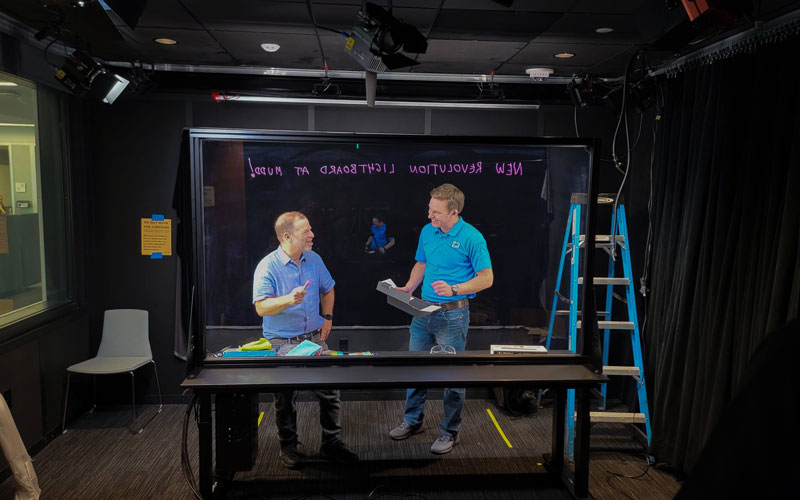The Evolution of Northwestern’s Newest Lightboard
Revolution Lightboards, a company founded by an alum and based on Professor Michael Peshkin’s invention, brings an updated lightboard studio to campus.

Watching Kevin Koch (’09 BS,MS ) demonstrate how a lightboard works is like viewing a scene from the movie Minority Report. Koch stands in front of a black curtain and writes in fluorescent marker seemingly in mid-air, pulls a browser window into the scene, and interacts with floating graphs and charts.
Of course, this isn’t movie magic. Invented by Northwestern Engineering professor Michael Peshkin, the lightboard is designed to create compelling visual presentations in the classroom or for video lectures. Since 2014, Koch's company, Revolution Lightboards, has been evolving the lightboard’s design and functionality. And this summer, the company installed an updated lightboard studio in Northwestern's Mudd Library, making the advanced presentation tool available to the entire University community.
From invention to company

In 2014, Koch came across Peshkin’s invention in an alumni newsletter. Intrigued, Koch discovered that Peshkin was seeking improvements for the lightboard, particularly for a better metal frame to support the glass. With his experience working at a manufacturing company in Iowa, Koch reached out to Peshkin to offer his expertise.
Their collaboration was particularly meaningful for Koch, who remembered Peshkin as an innovative and supportive professor during his time as a mechanical engineering student. Encouraged by Peshkin, Koch formed a company, Revolution Lightboards, to develop lightboard frames that could be easily shipped and assembled. The company shipped its first frame in June 2014, and over the years, has expanded to offer additional components, features, and complete systems to educational institutions and corporate clients.
“I think it's cool this came full circle,” said Peshkin, professor of mechanical engineering and codirector of the Segal Design Institute. “It’s ‘open-source hardware.’ So there’s nothing to stop anyone from starting a lightboard company. And, as nice as it was to retain myoriginal lightboard we had at Mudd Library, it’s much better to have a really slick and well thought out evolved product.”
The lightboard studio at Northwestern
Today, the lightboard studio in Mudd Library is available to the entire Northwestern community. The system is user-friendly: with a single button press and a Northwestern login, users can begin video recording. This ease of use is central to the lightboard’s purpose, Peshkin said.
“The main point of the lightboard is you can walk right in and do what you would normally do on a chalkboard. But classroom chalkboard lecture recordings can be dismal. On a lightboard, the lecturer is looking at the audience, they’re well lit, and the writing glows, so it’s super readable and compelling,” Peshkin said.
“We are very grateful for Michael Peshkin’s assistance over the past six years in both designing the original lightboard studio space and technology, and we’re grateful to Northwestern IT for their assistance as well,” said Bob Trautvetter, director of IT infrastructure at Northwestern University Libraries. “We’re hoping that the commercial product from Revolution Lightboards will allow us continue this very popular service at the library.”
For Koch, bringing the evolved lightboard to Northwestern is particularly gratifying.
“I'm very proud to bring back a product to the campus where I learned not only how to run a mill and a lathe, but also the business aspects of entrepreneurship,” Koch said. “It’s super cool to see how far your ideas can travel.”
